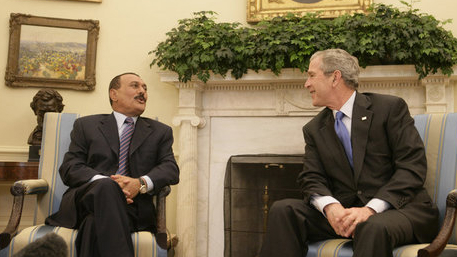Yemen: Salih’s Final Dance (Updated)

Early this morning Yemeni security forces stormed the tent city in front of Sanaa University, firing tear gas and live bullets in a desperate attempt to disperse the protesters. According to al-Jazeera Arabic at least two people were killed and a number of others wounded (the estimates vary widely, and it will likely be sometime before we know the full extent of this morning’s crackdown.)
Mareb Press has a the complete rundown (Ar.) of the morning’s events here, including the news that a Doctor Nashwan al-‘Ariyqi has been kidnapped and that the former Min of Defense, Abd al-Malik al-Sayani has joined the protesters.
(There are a number of rumors coming out of Sanaa at the moment, most of which I won’t pass along, but I’m confident – based on triangulating a variety of sources – that at least two things happened this morning: 1. Snipers were posted on buildings and 2. some ambulances were, at least initially prevented from reaching the Square of Change, where the protesters have been camped out.)
There was also a report that the Journalist’s Syndicate in Sanaa was attacked by “armed thug” looking to burn it and unconfirmed reports that journalists were targeted this morning (some reports claim that at least 8 were injured). All of this, of course, flies in the face of President Salih’s statement on Thursday that he had “ordered the security forces to continue to provide protection for all the protesters, whether they are supporters of our legitimacy or from the opposition.”
Following this morning’s attack – it is hard to call it anything else – protesters flowed into the streets in Taizz and Aden, and al-Jazeera Arabic has since been interviewing local correspondents on the ground, who tell of shots being fired in both places and people being shot.
For me, this morning represents a significant escalation by Salih and one that will likely lead to the collapse of his regime. But for the moment let’s take a step back and look at how Yemen got here in the last couple of days. Two things stand out to me.
First, there was this message from the US, telling Salih that the US supported his call on Thursday for the devolution of power. The White House went much further than it should have in calling on the opposition to support Salih’s plan.
This call demonstrates a fundamental misunderstanding of the situation in Yemen. The US is calling on the JMP to do something that it can’t possibly do at the moment in Yemen – it is impossible for the JMP to be seen as giving Salih a lifeline. The JMP has little support as it is in Yemen and negotiating with Salih would only destroy what little popular support it does have.
The US has failed to take into account how things in Yemen have changed over the past few months. Prior to that the US was doing a good job of remaining behind the scenes and acting as an intermediary between Salih and the JMP. Particularly, Ambassador Feierstein was winning high marks from both sides for listening, but times have changed and both the ambassador and the US have been piling up the mistakes in recent days. From the ambassador’s interview with a local Yemeni magazine calling for dialogue to the latest White House statement each move has mired the US deeper and deeper in the muck.
Particularly egregious was the State Department’s decision not to condemn acts of violence in Yemen. Not only did this embolden Salih but it spoke volumes to the demonstrators, telling them that the US is backing Salih and not democracy.
In Yemen, the US has chosen security interests over its values. I can’t stress enough how much of a mistake I consider this to be.
Not only will the US not have its security concerns met in the short-term, but it runs the risk of alienating so many in Yemen that the next government will be unable to publicly deal with the US. This will mean that the US will miss out on the window of opportunity to positively effect change in Yemen that will come after Salih falls. (Note: this window of opportunity will likely only be a matter of months, not years.) The US is mortgaging its next several months in Yemen right now on a series of mistaken public statements.
The second key factor in the build-up to this morning’s attack was this meeting Salih held last night with his military commanders -(Ar.) – (this came after the US’ statement). The article doesn’t say, but I would be willing to be all the money in my pocket against all the money in your pocket that the 60,000 new jobs wasn’t the only thing discussed at this meeting. If you are looking for the order for today’s crackdown, I would start with this meeting.
This leads us to the big question: what does it all mean?
To put it succinctly: this is the end for Salih in Yemen.
Yes, that is correct. Waq al-waq is predicting publicly that President Salih’s regime will fall. The only question left is when and in what manner he goes. But he will not survive this term.
The sooner the US recognizes this the better it will be for not only US policy in Yemen but for the security of the homeland – already people in Yemen are chanting against the US for its support of Salih. Getting shot at with US-made tear gas canisters doesn’t help either.
Salih has alienated too many different segments of society in Yemen. He can no longer survive as president. This is his final dance.
Update: for those interested in short, 140 character updates on Yemen you can follow me on twitter: gregorydjohnsen




